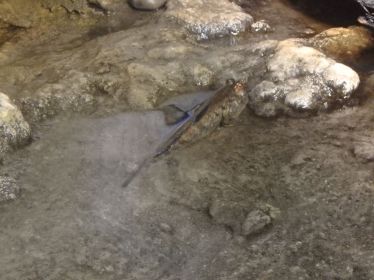- Ground sharks (Carcharhiniformes)
- Carpet sharks (Orectolobiformes)
- Stingrays (Myliobatiformes)
- Skates (Rajiformes)
- Bichir (Polypteriformes)
- Lungfish (Dipnoi)
- Gar (Lepisosteiformes)
- Eel (Anguilliformes)
- Bony-tongued fishes (Osteoglossiformes)
- Carps (Cypriniformes)
- Tetra (Characiformes)
- South American knifefish (Gymnotiformes)
- Catfish (Siluriformes)
- Salmon (Salmonidae)
- Pikes (Esociformes)
- Cod fish (Gadiformes)
- Cardinalfish (Kurtiformes)
- Gobies (Gobiiformes)
- Pipefish (Syngnathiformes)
- Gouramies (Anabantiformes)
- Flatfish (Pleuronectiformes)
- Cichlides (Cichliformes)
- Rainbowfish (Atheriniformes)
- Killifish (Cyprinodontiformes)
- Blenny (Blenniiformes)
- Wrasse (Labriformes)
- Anglerfish (Lophiiformes)
- Pufferfish (Tetraodontiformes)
- Scorpionfish (Scorpaeniformes)
- Ray-finned fish (Perciformes)
- Dragonet (Callionymiformes)
- Weever (Trachiniformes)
Atlantic mudskipper (Periophthalmus barbarus)

The Atlantic mudskipper (Periophthalmus barbarus) is a species of mudskipper native to fresh, marine and brackish waters of the tropical Atlantic coasts of Africa, including most offshore islands, through the Indian Ocean and into the western Pacific Ocean to Guam. The Greek scientific name Periophthalmus barbarus is named after the eyes that provide the Atlantic mudskipper with a wide field of vision. The Atlantic mudskipper is a member of the genus Periophthalmus, which includes oxudercine gobies that have one row of canine-like teeth.
The Atlantic mudskipper can grow up to 16 cm (6.3 in) in body length. Similar to other members of the genus, it has dorsally positioned eyes and pectoral fins that aid in locomotion on land and in water. Atlantic mudskippers can skip, crawl, and climb on land using their pelvic and pectoral fins.
Atlantic mudskippers are semi-aquatic animals that occur on tidal flats and mangrove forests, where it readily crosses mud and sand surfaces out of the water. The Atlantic mudskipper is carnivorous, and utilises an ambushing strategy to capture prey. Capturing prey is performed through the use of a 'hydrodynamic tongue', which involves using water to suction the prey into the mouth.
Sexual maturity is reached at approximately 10.2 cm (4.0 in) for females and 10.8 cm (4.3 in) for males. The Atlantic mudskipper can live around five years. Atlantic mudskippers have been used by humans for food, bait, and medicinal purposes. The conservation status of the Atlantic mudskipper is classified as 'Least Concern'.
In Aquariums and Zoos: common in european aquariums
The Atlantic mudskipper can grow up to 16 cm (6.3 in) in body length. Similar to other members of the genus, it has dorsally positioned eyes and pectoral fins that aid in locomotion on land and in water. Atlantic mudskippers can skip, crawl, and climb on land using their pelvic and pectoral fins.
Atlantic mudskippers are semi-aquatic animals that occur on tidal flats and mangrove forests, where it readily crosses mud and sand surfaces out of the water. The Atlantic mudskipper is carnivorous, and utilises an ambushing strategy to capture prey. Capturing prey is performed through the use of a 'hydrodynamic tongue', which involves using water to suction the prey into the mouth.
Sexual maturity is reached at approximately 10.2 cm (4.0 in) for females and 10.8 cm (4.3 in) for males. The Atlantic mudskipper can live around five years. Atlantic mudskippers have been used by humans for food, bait, and medicinal purposes. The conservation status of the Atlantic mudskipper is classified as 'Least Concern'.
In Aquariums and Zoos: common in european aquariums
woaqzo@yahoo.com